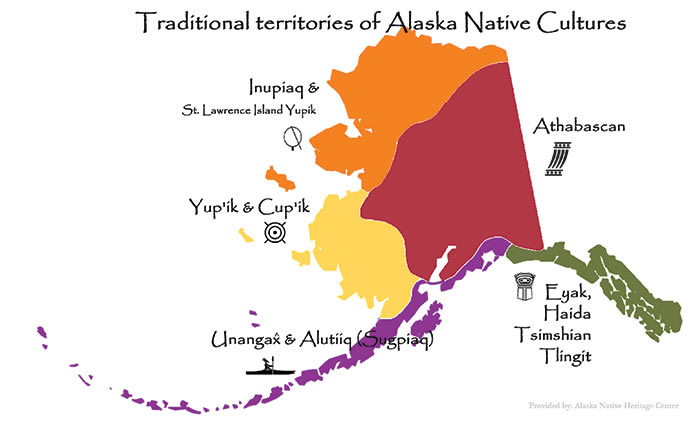Alaska Natives Peoples Native Indians Eskimos
Mục Lục
Revitalization:
Today, Alaska Natives account for just over 15 percent of the total Alaskan population of approximately 648,000 people. Since the 1960s and 1970s, aboriginal autonomy has rebounded in Alaska. The Alaska Native Claims Settlement Act of 1971 officially ended native land ownership claims while creating regional corporations that administered approximately one-ninth of Alaskan territory; the shareholders of the corporations are the native peoples. The legal battles for rights to their ancestral land began a revitalization of native society that is evident today.
If you visit Anchorage, make sure to visit the Alaska Native Heritage Center while you are there.
Native Peoples
Aleuts:
The Aleuts, who call themselves Unangan, lived in the Aleutian Islands off the coast of mainland Alaska. St. Paul Island, Alaska. Some anthropologists believe their ancestors migrated to the Aleutians 7,000 years ago. Aleuts had both permanent and seasonal homes. Permanent Aleutian villages consisted of underground homes mainly located on the northern coasts of the islands that faced the Bering Sea, due to the abundance of resources on that side. Aleutian culture is based heavily on the sea. They are famous fishers and hunters, and are known for their basketry.
Inuit:
The Aleuts lived on ice-free waters, but the Inuit (who are also known as the Eskimo) were surrounded by the icy northern seas of Western Alaska. As a result, the Inuit were more mobile that the Aleuts. One distinguishing feature of the Inuit Eskimo, family, in Alaska was their near total dependence on the sea. Their food, clothing, furnishing for their homes, and fuel all came from the marine life that they hunted, such as whales and seals. Their homeland stretches from the northeastern tip of Russia across Alaska and northern Canada to parts of Greenland. Inuit refers to the people formerly called Eskimos. The term Eskimo comes from a Native American word that may have meant ‘eater of raw meat’. They prefer the name Inuit, which means ‘the people’ or ‘real people’ and comes from a language called Inuit-Inupiaq.
As the Inuit spread eastward, they modified their way of life to suit the Arctic environments they encountered. They caught fish and hunted seals, walruses and whales. On land, they hunted caribou, musk oxen, polar bear and other small animals. They used animal skins to make tents and clothes. They crafted tools and weapons from the animals’ bones, antlers, horns and teeth. In summer, they traveled in boats covered with animal skin, called kayaks and in winter, on sleds pulled by dogteams. Most Inuit lived in tents in the summer and in large sod houses during the winter. When traveling in search of game in winter, they built snowhouses (igloos).
Inupiat:
The Inupiat have inhabited the harsh arctic environment for more than 10,000 years. The ancestral Inupiat crossed the Bering Land Bridge from Siberia. Some of the early migrants continued their journeys to the east and south. Those who remained in the region gradually established camps, small villages and trading routes. They are skilled hunters and gatherers an subsist on whale, fish,
caribou and moose. Their diet is supplemented with berry and root plants native to the region.
Aleuts:
The Aleuts are the native inhabitants of the present Aleutian islands stretching for about a thousand miles southwestward from the Alaskan mainland. Primarily a sea-going people, the Aleuts were adept at harvesting resources of the sea (sea lion, seals, whales, and fish) in their skin-covered boats as well as those of the land (birds, eggs, and plants).
Yup’ik:
The Yup’ik people live mainly in the coastal watersheds of the Yukon and the Kuskokwim Rivers both of which flow westward through Southwest Alaska and drain into the Bering Sea.
Athapaskans:
Having continuously inhabited the land for several thousand years, Athapaskan society exemplifies how humans can maintain a sustainable coexistence with their environment. Subsisting on the rich natural resources provided by the northern boreal forest, they have developed a deep respect for both the land and its animals.
Tlingit:
The origin of the Tlingit people is not certain. It is possible the people came from the coast of Asia and Japan migrating north and east across the Aleutians and Gulf of Alaska into Southeast Alaska. Art forms and physical features of the Tlingit are similar to some Pacific groups.
Southeast Alaska provided an idyllic setting for the villages and contained abundant local resources. The forests supplied shelter, game and wild berries while the ocean was a storehouse of fish and sea mammals. In contrast to the Arctic peoples of Alaska, the Tlingits spent relatively little time surviving and were able to become traders and craftsmen.
Haida:
The original homeland of the Haida people is the Queen Charlotte Islands in British Columbia, Canada. Prior to contact with Europeans, a group migrated north to the Prince of Wales Island area within Alaska. This group is known as the “Kaigani” or Alaska Haidas. Today, the Kaigani Haida live mainly in two villages, Kasaan and the consolidated village of Hydaburg. Before the Haida came in contact with Europeans, most Haida wore clothes made of woven red or yellow cedar bark. Women wore skirts and capes and men wore long capes. The Haida’s main food sources were the salmon and eulachon fish. The eulachon was highly prized because, besides being good to eat, its oil could be used for lighting lamps.







